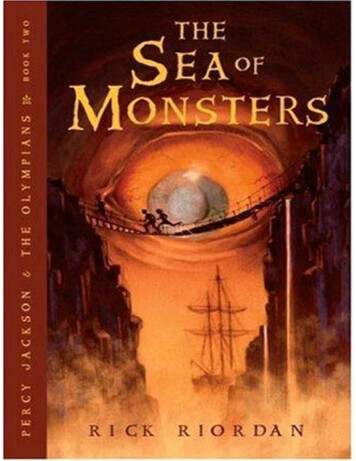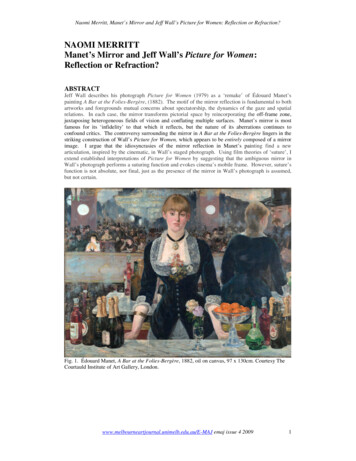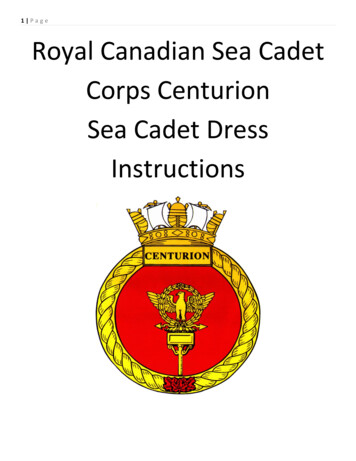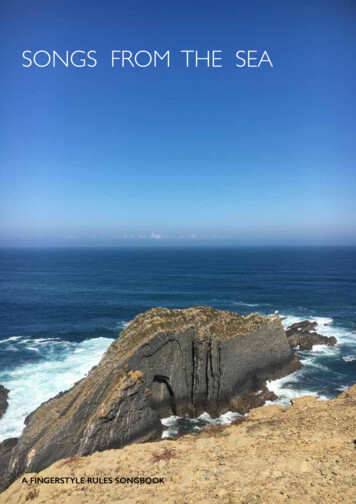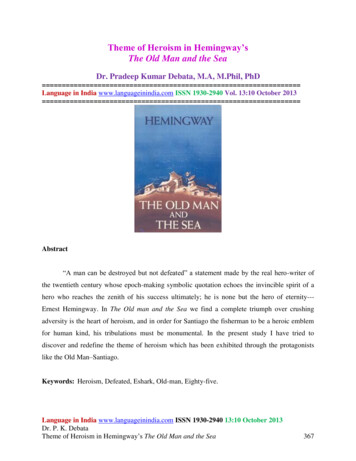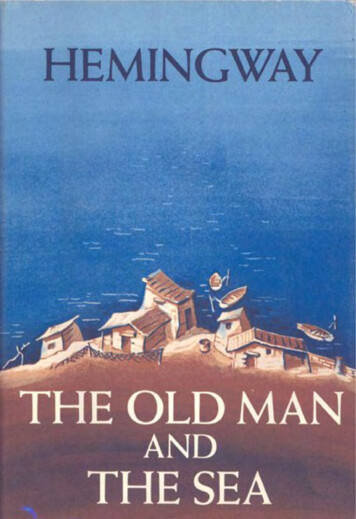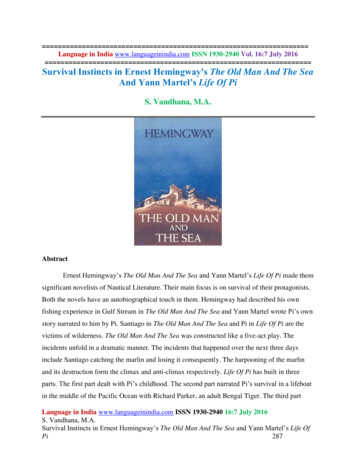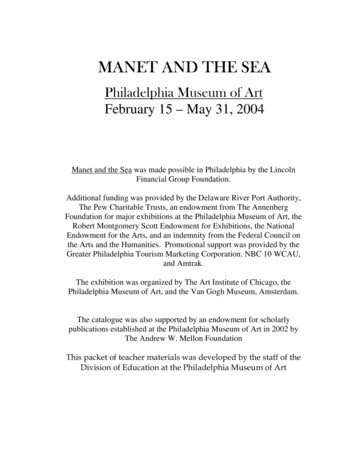
Transcription
MANET AND THE SEAPhiladelphia Museum of ArtFebruary 15 – May 31, 2004Manet and the Sea was made possible in Philadelphia by the LincolnFinancial Group Foundation.Additional funding was provided by the Delaware River Port Authority,The Pew Charitable Trusts, an endowment from The AnnenbergFoundation for major exhibitions at the Philadelphia Museum of Art, theRobert Montgomery Scott Endowment for Exhibitions, the NationalEndowment for the Arts, and an indemnity from the Federal Council onthe Arts and the Humanities. Promotional support was provided by theGreater Philadelphia Tourism Marketing Corporation, NBC 10 WCAU,and Amtrak.The exhibition was organized by The Art Institute of Chicago, thePhiladelphia Museum of Art, and the Van Gogh Museum, Amsterdam.The catalogue was also supported by an endowment for scholarlypublications established at the Philadelphia Museum of Art in 2002 byThe Andrew W. Mellon FoundationThis packet of teacher materials was developed by the staff of theDivision of Education at the Philadelphia Museum of Art
MANET AND THE SEAThis is the first major exhibition to explore the seascapes ofManet and his contemporaries such as French ImpressionistsMonet, Renoir, and Morisot, Realist French painters such asCourbet and Romantic artists like Delacroix. In addition theworks of several seventeenth century Dutch marine paintersare also exhibited. Innovation and experimentation inpainting techniques as well as the advent of seaside tourismin nineteenth century France are addressed in thisfascinating exhibition. The show consists of approximatelyone hundred works of art from sixty public and privatecollections.A Note to Teachers on the Use of this Teacher Packet:Enclosed are teaching materials related to the exhibition.These materials may be used in your classroom before, after,or instead of visiting the exhibition. With your expertise,these materials may be adapted to suit any age group.CONTENTS:1. Biography of Edouard Manet2. Biographical notes on additional artists in the exhibition3. Poster of Manet’sThe Battle of the U.S.S. “Kearsarge” & the C.S.S.“Alabama”4.5.6.7.8.Set of eleven slides of works from the exhibitionSlide script with discussion questionsWriting activities for K-5th grade andWriting activities for 6th-12thDrawing activity
9. Chronology from the exhibition catalog10. Art Vocabulary Terms11. Resources
Biography of Edouard ManetEarly Life and EducationEdouard Manet was born into a prosperous family on January23, 1832, in Paris, France. He was the oldest son of Auguste Manet,a government official, and Eugénie Desirée Manet, (formerlyFournier), the daughter of a diplomat. He had two younger brothersEugene (born in 1833) and Gustave (born in 1835).Edouard was not a particularly well-behaved student and wasso outspoken that he even contradicted his teachers. His classmateand friend Antonin Proust, (who later became the French minister ofculture), wrote of the following incident in his memoirs:Manet was about fifteen years old when he read the philosopherDiderot’s essays of art criticism Les Salons (1759-1779) as part of ahistory class. According to Proust, Manet objected to Diderots’criticism of artists for portraying hats “that were condemned to becomeoutmoded.” Manet said “‘that is extremely stupid. One has to be in stepwith one’s time, produce what one sees without worrying about fashion.”Manet doodled and sketched caricatures of his fellow studentsin the margins of his notebooks. His maternal uncle, CaptainEdouard Fournier, noticed Edouard’s talent at drawing andencouraged him by frequently taking Edouard and his brotherEugene to art museums.Edouard’s father served as a judge and he wanted his son tostudy law, but Edouard was not a particularly good student, so hethought he would become a sailor. After he failed the test to get intothe French naval officers’ school, he worked on a small ship in orderto learn more about sailing before retaking the navy’s entrance exam.In December of 1848, when he was just sixteen years old, Manetbegan a training voyage on board Le Havre et Guadeloupe, a threemasted ship that sailed from France to Brazil. During the voyageEdouard’s drawing ability gained recognition. Manet described thisin a letter to his mother in 1849: “I have to tell you that I developed areputation during the crossing. All the ships’ officers and all the instructorsasked me to make caricatures of them. Even the captain asked for one, as hisChristmas present.”1
It was during this time that Manet really began to understandthe relationship between the ship and the surrounding sea and sky.He was said to have described the experience to another artist asfollows: “I learned a lot on my voyage to Brazil. I spent countless nightswatching the play of light and shadow in the ship’s wake. During the day, Istood on the upper deck gazing at the horizon. That’s how I learned toconstruct a sky.”When he returned to Paris in 1849, Manet failed the navalacademy’s entrance exam again. His parents agreed to let Edouardfollow his dream of studying to become an artist. After first objectingto his son’s choice of where to study art, Manet’s father eventuallyallowed Edouard to work in the studio of one of the more innovativeFrench artists of the time, Thomas Couture. Edouard spent six yearsstudying with this genre and history painter.Like most artists of the nineteenth century, a large portion ofManet’s education took place in museums. He spent countless hoursin the Louvre copying paintings by famous artists including the workof Titian, Tintoretto, Rubens, and Boucher among others. He alsovisited the Rijksmuseum in Amsterdam, as well as taking the “grandtour” of great art in Florence and Venice. In 1856, Manet saw thework of Velasquez that was on loan to Vienna from Madrid, andVelasquez became a great influence on his work.Spanish InfluencesSpanish art and culture became extremely popular in Franceduring the late 19th century, and French novelists, poets, artists, andcomposers helped make Spain fashionable. Two main styles ofwriting and art that inspired French artists during this period wereRomanticism and Realism, and both styles of painting were inspiredby the art of Spain. Manet was particularly drawn to Realism as itpresented a stark contrast to the traditional art of classical Greece andItaly that dominated the academic French painting of the nineteenthcentury.Manet’s portrait of a man singing and playing a guitar entitledThe Spanish Singer was his first painting accepted into the annualSalon, (major French exhibition), in 1861. He continued to paintSpanish themes before he ever went to Spain, but stopped painting2
them shortly after his return from traveling to Spain in 1865. Eventhough he no longer painted Spanish subjects, he incorporated thestyles of Spanish artists such as Goya and Velasquez in his ownwork. In reference to his favorite Spanish artist he wrote that “Whatcaptivated me most about Spain, what alone was worth the trip, wasVelasquez. He is the painter’s painter.The sight of these masterpieces gaveme great hope and confidence.”Dutch InfluencesIn addition to Velasquez and other Spanish artists, Manet was alsogreatly influenced by the Dutch artists of the 17th century. He wasparticularly inspired by the Frans Hals’ work he saw during a trip toHolland in 1872. The rapid brushstrokes of Hals convinced Manet totry the Impressionist’s method of painting directly from life. Manetalso noted that Hals’ style reminded him of Spain. ”I cannot get it outof my head, that Frans Hals must have been of Spanish descent. There wouldbe nothing surprising about that. He was from Mechelen”. (Spainoccupied the city of Mechelen in the 16th century.) Manet managedto blend the art of Velasquez and Hals in his painting The SpanishSinger. This painting received praise from the critics and the publicwhen it was exhibited in 1861. It was an early success for Manet wholater had little praise from the official Salon.Manet’s FriendsAlong with Spanish and Dutch masters of the past, Manet wasinfluenced by classical Italian and French painters of the past andcontemporary French artists. Manet was close friends with many ofthe most influential artists, writers, and musicians in nineteenthcentury France. They influenced each other’s work and oftensupported one another in gaining public recognition.He met several of these friends during his time studying the oldmasters in the Louvre; they included the painters Henri FantinLatour, Edgar Degas, and Berthe Morisot. Other contemporarypainters that Manet admired included the landscape paintersGustave Courbet, Camille Corot, and Johan Barthold Jongkind.3
Writers such as Charles Baudelaire, Emile Zola, Stephane Mallarmé,and others published work about Manet and his painting. They oftenpraised Manet’s unique style of painting when others werecruel in their critical reviews of Manet.Manet’s FamilyManet met his future wife when he was seventeen and she wasnineteenin 1849. Suzanne Leenhoff was a talented pianist who cameto Manet’s house to give piano lessons to his younger brothers.Three years later, Suzanne gave birth to a son named LéonEdouard in 1852 and many people believe that Manet was the father.Manet kept this secret as he never seemed to tell anyone that Léon Edouard was his son. Suzanne was also secretive about Léon’sorigins as she often referred to him as her younger brother. Maneteventually married Suzanne in 1863 and Léon continued to live withthem and he called Manet “godfather”. Léon often posed for Manet;once as a Spanish pageboy holding a sword at age nine.Manet’s Subject MatterManet painted everything from portraits to still-lives toseascapes. He was particularly interested in painting the humanfigure in costumes, contemporary dress, and nude. He painted manyexquisite and intimate still-lives, many of which include beautifulflowers. Many of his best known works include figures and still-livesin scenes of contemporary life. He also enjoyed painting animals,including horses and cats. He wasn’t particularly interested intraditional landscapes except as a background for portraiture, but heloved to paint the sea.As a lifelong resident of Paris, Manet was particularly drawn toscenes of daily life in the city; both interiors and exteriors. While heoften sketched or did watercolors en plein air (outside, directly fromlife), he usually did his finished oil paintings in his studio.Manet was most interested in capturing moments of contemporarylife in his work. While he frequently borrowed classical compositionsfrom the old masters, he wanted his work to depict the modernFrench life around him.4
Manet’s StyleManet had a unique style of painting that really set him apart fromother artists of his time. While Manet’s subject matter was oftenshocking to the public, in some ways his style of painting was evenmore unacceptable to the traditional academic art world of his day.Manet’s technique of paring down the elements of the painting to thebasic contrasts of dark and light, and flat background and simplifiedforeground, disturbed many nineteenth century critics. He paintedevery part of the painting with equal care and didn’t emphasize onething over another. This was in marked contrast to traditional artistswho had specific narratives which gave more weight to certain areasof their painting. Ultimately, it is Manet’s style that makes him arevolutionary painter who influenced the future of western art andinspired the modern artists who followed Manet’s path.Manet combined elements of classical painting, contemporaryImpressionism, traditional Japanese woodcuts, and Spanish mastersto forge his unique style. He blended the dramatic contrasts of lightand shadow, popular in 17th century Dutch paintings by Rembrandtand others, with the quick brushstrokes of the Impressionists. Manetborrowed the flat backgrounds, use of velvety blacks and unusualperspectives and compositions from Japanese art to depict scenesfrom contemporary French society. Essentially everything that Manetadmired from classical antiquity and Italian Renaissance art to thework of his French peers became part of an entirely modern style ofpainting.While Manet’s work was both highly praised and vehementlyprotested by others during his lifetime, it is not entirely clear howManet felt about it. He certainly held himself and his art in highregard, but he seemed somewhat unconscious of how far he hadcome from the art of the past. He desperately wanted to achievesuccess in the art world of his day and was surprised by the fact thatmany of his paintings were rejected by the official Salon. Since Manetwas conscious of all his allusions to the past, he failed to understandwhy the judges and public found his art unacceptable. Dismayed byhis lack of success in the Salon, Manet created his own private showof fifty of his pictures in 1867. In the accompanying exhibition5
catalog, Manet wrote about himself in the third person: “It is sinceritythat gives these works a character that makes them resemble a protest, albeitthat the painter’s only aim was to render an impression.”Manet’s LegacyManet died on April 20, 1883 at the age of 51. While it isimpossible to know exactly how Manet felt about his work, it iscertain that his work had a tremendous impact on his fellownineteenth century French artists and continues to exert influence onartists today. He lived at a pivotal time in the history of art andconsciously or not, Manet’s ingenuity provided a turning point for allthe modern art that followed in its wake.6
Biographical Notes on Additional Artists in the Exhibition Eugene Boudin (1824-1898) FrenchThe son of a mariner, Eugene Boudin grew up in the Frenchcoastal city of Le Havre. He gained recognition with his earlycloud pastels exhibited in the Salon of 1859. Boudin’s paintings ofatmospheric landscapes and depictions of tourist activities atseaside resorts influenced younger Impressionist artists. Eva Gonzales (1849-1883) FrenchEva, Manet’s only student, created over one hundred works of artbefore her premature death at the age of thirty-four. Most of herpaintings depict women and children in domestic settings, but shealso did several landscapes and seascapes. Gustave Courbet (1819-1877) FrenchCourbet painted everything from landscapes and modern life tofigures and seascapes. Courbet was the father of Realism inFrench painting and he specialized in painting ordinary people.His later work included numerous seascapes which influencedother artists who painted the sea with him. These artists includedBoudin, Monet, and Whistler who inspired Manet’s paintings ofthe sea. Ferdinand-Victor-Eugene Delacroix (1798-1863) FrenchDelacroix was considered the leader of Romanticism in Frenchpainting. The Romantic style of painting was subjective anddramatic. Romantic painters were frequently drawn to heroicnarrative subjects from history and religion. Realist painters weremore concerned with giving an objective view of ordinary peopleand modern daily life. Pierre-Julien Gilbert (1783-1860) FrenchGilbert held the post of official painter of the French Navy. He andother official painters were commissioned to create hundreds ofpaintings documenting the history of French naval battles.1
Louis-Gabriel-Eugene Isabey (1803-1886) FrenchEarly in his life, Isabey was an officer in the French Navy and hisdrawings were used by Gilbert and other official Navy painters.Later, Isabey became a famous marine painter and taught otherimportant artists such as Boudin. Johan Barthold Jongkind (1819-1891) born in the NetherlandsJongkind was the key figure who introduced the long tradition ofDutch seascapes to nineteenth century French artists. Jongkindoften worked directly from life,(en plein air), and frequently Monetpainted with him at the seaside. Léopold LeGuen (1828-1895) FrenchLeGuen was a traditional marine painter with a Romantic style. Berthe Morisot (1840-1926) FrenchMorisot and Manet were close friends who influenced andadmired each others work. Morisot married Manet’s brotherEugene and became Edouard’s sister-in-law. Morisot was lessformal and traditional than Manet in her style, and this led to herclose association and frequent exhibitions with otherImpressionists. Claude Monet (1840-1926) FrenchMonet spent his childhood in Le Havre, a city on the coast ofNormandy. He continued to paint the ocean, as well as otherbodies of water throughout his long life. He influenced and wasinfluenced by Jongkind, Boudin and Manet. Auguste Renoir (1841-1919) FrenchRenoir only painted a few marine paintings, but they wereinnovative in their experimentation. In some of his seascapes heused impasto (thick textured layers of paint) and many colors tocreate exciting, almost abstract images of the ocean.2
Willem van de Velde the Younger (1633 –1707)Dutch, (active in Amsterdam and London)This artist was considered to be the best seventeenth-centuryDutch marine painter. His dramatic use of light and shadow andbold compositions inspired marine painters for centuries. Lieve Verschuier (c. 1630-1686) DutchVerschuier’s marine paintings depicted daily life and technology. James McNeill Whistler (1834-1903) American, (active inEngland)Whistler spent time in France and painted en plein air withCourbet. Whistler and Manet were both interested in seascapes,Japanese prints, and naval battles.3
MANET SLIDE SCRIPTINTRODUCTION:These slides represent only a small sample of the wide range of work in theexhibition. There are works by over a dozen different artists in the show. Hopefullythe following carefully selected slides will encourage you to learn more aboutManet and The Sea.1. Léopold LeGuen, (1828-1895), Naval Combat Between “The Rights ofMan” and the English Vessel “Indefatigable” and the Frigate “Amazon”,January 17, 1797, 1853, oil on canvas, Musee des Beaux-ArtsManet’s paintings of the sea were strongly influenced by the use ofcomposition, light, shadow, and color in seventeenth century Dutch marinepainting, and by the paintings of his nineteenth century Frenchcontemporaries.There was a long tradition of painting naval battles by official painters whospecialized in this genre. In this painting, the artist Léopold LeGuenemphasized the dramatic elements and details in a specific naval battle scene.Questions: Describe the scene; what words or phrases would you use? List some details in the painting; are there a lot of them? List the different colors; how many can you find?
How did the artist make it look dramatic? What contrasting elements can you find in the painting? How did the artist highlight the horizon line? Can you tell which side is winning this sea battle? How?2. Edouard Manet,(1832-1883), The Battle of the U.S.S. “Kearsarge” & theC.S.S. “Alabama”, 1864, oil on canvas, Philadelphia Museum of Art* Optional: Use this same script and set of questions with the posterThis is Manet’s first seascape and it depicts a real event that Manet readabout in newspapers and illustrated journals. The naval battle occurred onJune 19, 1864, between the U.S. naval ship Kearsarge and the Confederateraider Alabama. Despite the fact that this was an American Civil War battle,it was of particular interest to the French as it occurred off the coast ofnorthern France near Cherbourg. Although Manet did not witness the actualevent, he painted a realistic painting, and later went on to see and paint theKearsarge from life when it was in the harbor near Bolougne.Manet was not the first artist to paint this battle scene and it is possible thatan earlier depiction of the same event by the naval painter Henri Durand-
Brager inspired Manet to attempt the same subject. Durand-Brager’s versionattracted a lot of favorable attention and public notice. Many people saw andcommented on Manet’s painting when it was exhibited in the window of aprint shop in Paris in July, 1864. Most people assumed that Manet hadwitnessed the actual battle and was painting from life and from memoryrather than from his imagination and other images and written accounts of thebattle.Questions: Why do you think that people assumed that Manet was painting from life? If using slides, compare and contrast this painting with the painting by LeGuen. How are they similar? What is different in the two paintings? What percentage of the painting depicts the sea and how much is sky? Where is the horizon line? Is it easy to see? Is it clear exactly what is going on? Why? Where would you need to be to see this scene? How does the painting make you feel? Do you think Manet wanted you to have astrong emotional reaction to the scene, why or why not?When Manet exhibited this painting at the Paris Salon, it was received with bothpraise and criticism. One critic wrote:“Untroubled by the vulgar bourgeois laws of perspective, M. Manet conceivesthe clever idea of giving us a vertical section of the ocean, so that we may readthe physiognomy of the fishes for their impressions of the conflict taking placeabove their heads,”Another critic described Manet’s canvas as:“First and foremost a magnificent piece of marine painting.” Which critic do you agree with? What arguments would you present to proveyour position?Optional activity: Break students up into two sides and let them debate their case. Is this how you would have portrayed this scene?If not, what would you have done differently?
3. Eugene Boudin, (1824-1898), Beach at Trouville, 1863 oil on panel,National Gallery of Art, Washington, D.C.Collection of Mr. and Mrs. Paul Mellon, 1983Boudin began painting fashionable vacationers at the beach in 1860, and bythe time this painting was made, his beach scenes were very popular. Since hegrew up near the sea and was the son of a sea captain, he was very familiar withthe subject. Vacationing at the seaside became popular in France afterrailroadswere built linking Paris to the coast.Manet and Boudin knew and admired each other’s work , but it is unclearwhether they ever met each other. Boudin gained fame as an artist who painteddirectly from life and captured the light and atmosphere of particular moments inhis landscapes. Boudin created some of the first truly impressionist landscapeswhich influenced Manet and others.Questions: How is this painting similar to and different from the two battle scenes? What is the subject matter of this seascape? What are the people doing in this scene? How are these vacationers different from modern people on a beach?Do you think that Boudin painted this from direct observation? Why?
4. Edouard Manet, The Beach at Boulogne, 1868, oil on canvas,Virginia Museum of Fine Arts, Richmond.Collection of Mr. & Mrs. Paul MellonManet and his family made many visits to the new seaside resorts. Whilethere Manet made many sketches and paintings. Like Boudin’s earlierpainting, Manet’s scene describes the leisure activities of vacationers at theseaside. At first glance the two paintings appear to have been done onlocation. Modern x-ray technology reveals that Manet actually repaintedlarge portions of his picture suggesting that much of it was from memory andsketches as opposed to Boudin’s which was probably done on location. Mostof the figures in Manet’s painting are directly related to drawings in hissketchbook.Notice the cart at the water’s edge on the left; it is called a bathing machineand was used to transport swimmers into the water in privacy. Once the cartwas in the water, a person would step down a makeshift step-ladder into theocean. The purpose of the bathing machine was to preserve the modesty ofthe discreet nineteenth century people who were unaccustomed to revealingtheir bare arms and legs in public.Questions:Compare and Contrast:How is this painting similar to the painting by Boudin?In what ways is it different? Discuss the following aspects: Compare the activities of the tourists on the beach in each painting. Describe the weather in the two paintings. How are the two compositions similar? How are they different?
5. Edouard Manet, Moonlight, Boulogne, 1868, oil on canvas Musee d’Orsay,Paris. Bequest of Comte Isaac de Camondo, 1911This painting was one of Manet’s favorites. He thought it captured realityin an “honest” way. It may have been painted from Manet’s hotel window,directly from life, as well as from several quick watercolor studies and pencildrawings of Boulogne found in his sketchbook.The subject was a specific French harbor scene at night, but it looks similarto earlier seventeenth century Dutch paintings. Manet went to Holland severaltimes including a couple of visits before he painted this scene.Note the ways in which Manet used contrasts of light and dark to create adramatic image. Look at how well balanced the various objects are in thecomposition as well as the way in which Manet created the illusion of space inthe painting.Questions: What makes this painting different from all the others you saw so far? What similarities does it have to the others? How many different light sources can you see? Describe each of them. Why do you think Manet liked this painting so much? What can you see in the foreground? What is in the middle ground? Describe the background.
How does this painting relate to the following famous Manet quote:“Look for the grand light and grand shadow, the rest will come of itself, and oftendoesn’t amount to much anyway”?6. James Abbott McNeill Whistler, (1834-1903),Crepuscule in Flesh Colour and Green: Valparaiso, 1866, oil on canvas,Tate, London. Presented by W. Graham RobertsonWhistler and Manet influenced one another for over twenty years, enjoyingcompetitive admiration for each other’s work. Whistler was particularly inspiredby Manet’s painting, The Battle of the U.S.S. “Kearsarge” & the C.S.S.“Alabama” of 1864. The journalistic aspect of this painting of an actual eventwas of particular interest to Whistler.In 1866, Whistler sailed from his home in London, England toValparaiso, Chile. He was on a mission to deliver torpedoes to destroy theSpanish Pacific fleet which was at war with Peru and Peruvian alliedcountries including Bolivia, Ecuador, and Chile. American, English, andFrench governments sent ships to help stop the Spaniards fromdestroying Valparaiso. Unfortunately, the American, English, and Frenchwere unable to prevent the attack as they were not officially at war withSpain. Later in life, Whistler remembered the scene:“There was the beautiful bay with its curving shores, the town of Valparaiso onone side, on the other the long line of hills. And there, just at the entrance of the
bay, was the Spanish fleet, and in between, the English fleet and the French fleetand the American fleet and the Russian fleet And when morning came, withgreat circles and sweeps, they sailed out into the open sea, until the Spanish fleetalone remained.”The Spanish proceeded to bombard the defenseless port of Valparaisofor over two hours. Whistler witnessed this violence from a hilltop situateda safe distance from the action.Questions: Which Manet works that we have seen so far are similar to this? Why? Can you tell what time of day it is in Whistler’s painting? What words would you use to describe the mood of this painting? How does he create this feeling? (color, light and shadow, etc.)7. Claude Monet, ((1840-1926), Garden at Sainte-Adresse, 1867, oil oncanvas, The Metropolitan Museum of Art, New York. Purchase, specialcontributions and funds given or bequeathed by friends of the MuseumPeople have confused Monet with Manet from the time the two artists werealive until now. The two artists were both friends and friendly competitors whoinfluenced each other throughout their careers. Monet was one of the first artists
to convince Manet to try painting outdoors, and Manet called Monet “theRaphael of water”. Manet provided financial support to the younger and lessprosperous Monet. In addition to the similarity of their names, the two Frenchpainters were often drawn to similar subjects such as the sea.Monet grew up by the sea in the coastal town Le Havre. When he was achild he often enjoyed playing on the beach. In this painting Monet has chosento paint a scene from his stay at his Aunt’s villa by the sea. The man sitting onthe chair on the right is Monet’s father and the others are also family members.They are relaxing in the bright sunshine in a garden overlooking the sea.Questions: How is this painting different from all the others that you have seen so far? In what ways is it similar? How did Monet convey the weather and time of day? Does this painting seem quiet and still? Why, or why not? What would be challenging or difficult about painting this scene from life?Whistler used long brushstrokes of thin paint to make his painting. Describe Monet’s use of brushstrokes. What details do you see in this painting? Are there a lot of them?8. Berthe Morisot, (1841-1895), The Harbor at Lorient, 1869, oil on canvas,National Gallery of Art, Washington, D.C. Ailsa Mellon Bruce Collection
Berthe Morisot and Edouard Manet were close friends who admired andinfluenced each other’s work. Morisot married Manet’s brother Eugene and Manetpainted several portraits of Morisot. Though Morisot, who was a pivotal participantand organizer of Impressionist exhibits helped Manet to appreciate paintingoutdoors (en plein air), Manet never formally associated himself with theImpressionists, preferring to show his work in the traditional Salon exhibitions.This painting was probably Morisot’s first seascape. She painted it during avisit to her sister who had recently married a naval officer stationed in the Frenchcoastal town of Lorient. Morisot tried to capture the “figure in the outdoor light”in this fresh, informal painting of her sister Edma seated on the wall by the harbor.Manet liked this painting so much, that Berthe gave it to him as a presentNote the painter’s broad use of white and her rapid br
Manet was about fifteen years old when he read the philosopher Diderot’s essays of art criticism Les Salons (1759-1779) as part of a history class. According to Proust, Manet objected to Diderots’ criticism of artists for portraying hats “that were condemned to become outmoded.”
